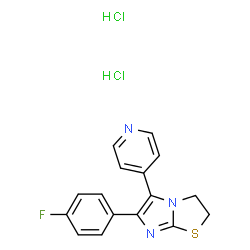116339-68-5
| Name | SKF 86002 dihydrochloride |
|---|---|
| Synonyms |
6-(4-Fluorophenyl)-5-(4-pyridinyl)-2,3-dihydroimidazo[2,1-b][1,3]thiazole dihydrochloride
6-(4-Fluorophenyl)-5-(pyridin-4-yl)-2,3-dihydroimidazo[2,1-b][1,3]thiazole dihydrochloride Imidazo[2,1-b]thiazole, 6-(4-fluorophenyl)-2,3-dihydro-5-(4-pyridinyl)-, hydrochloride (1:2) |
| Description | SKF-86002 dihydrochloride is an orally active p38 MAPK inhibitor, with anti-inflammatory, anti-arthritic and analgesic activities. SKF-86002 dihydrochloride inhibits lipopolysaccharide (LPS)-stimulate human monocyte IL-1 and TNF-α production (IC50 = 1 μM). SKF-86002 dihydrochloride inhibits lipoxygenase- and cyclooxygenase-mediated metabolism of arachidonic acid[1][2][3]. |
|---|---|
| Related Catalog | |
| In Vitro | SKF-86002 dihydrochloride (10 μM; 1 hour) inhibits apoptosis induced by stress stimulation with UV irradiation (UV)[1]. SKF-86002 dihydrochloride does not inhibit UV-induced apoptosis in undifferentiated HL-60 cells[1]. SKF-86002 dihydrochloride (10 μM; 72 hours) prevent IL-4-induced monocyte or U937 cell CD23 surface expression and protein formation with no effect on CD23 mRNA levels[4]. Western Blot Analysis[4] Cell Line: U937 cells Concentration: 10 μM Incubation Time: 72 hours Result: Reduced CD23 levels on IL-4-treated U937 cells. |
| In Vivo | SKF-86002 dihydrochloride (10-90 mg/kg; p.o.; daily; for 22 days) has antiarthritic activity[5]. Animal Model: Lewis rats, with adjuvant-induced arthritis (AA)[5] Dosage: 10 mg/kg, 30 mg/kg, 90 mg/kg Administration: Oral administration, daily, for 22 days Result: Significantly decreased hindleg volumes after injection of adjuvant. |
| References |
| Molecular Formula | C16H14Cl2FN3S |
|---|---|
| Molecular Weight | 370.272 |
| Exact Mass | 369.026947 |
| Appearance | powder |
| Storage condition | Store at -20°C |
| Water Solubility | Soluble to 50 mM in sterile water |
| Hazard Codes | Xi |
|---|
